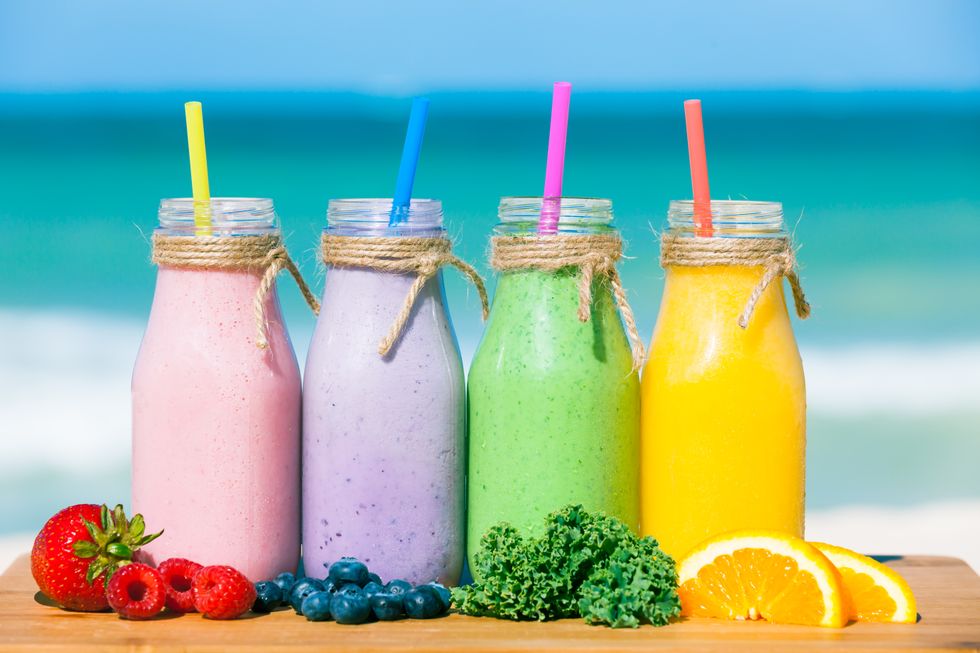
They can fill the day with a healthy liquid habit. It takes good fruit and vegetables, an ad hoc appliance, and a little curiosity. And also a little attention, not to overdo it ...
"What do we eat for lunch?" The question could now be slightly retouched: "What do we drink for lunch?". Centrifuges, live juices, smoothies, smoothies, joylent. Liquid food, indisputably healthy, is not only a trend, but a phenomenon that is really becoming a habit for many people in a short time. Raw and fresh fruits and vegetables - and it is important that they are in season - are truly a source of well-being. But be careful: all of this must not happen at the expense of fiber, whose presence in the diet is essential. Simply put, drinks don't have to completely replace the consumption of whole fruits and vegetables.
Once with us there were only the exotic milkshakes which, despite appearances, were often nothing more than powder in a bag and lots of ice. Today's meal-drinks, or at least snack-drinks, present themselves instead as the real healthy, and in many cases without a doubt they are, even if automatically associating them with a cure-all is not correct - first of all, if the fruit and vegetables in departure is littered with chemicals.
Meanwhile, let's see the differences between the various forms of meals that do not need cutlery. The contemporary icon is the centrifuged. The fundamental difference between these and the other categories is the centrifuged juice contains very few fibers: the “fluid essence" is extracted from fruit and vegetables. To tell the truth, what really "extracts" the juice is the extractor, a machine different from the classic centrifuge. If the first runs "hot", the extractor works "cold".
From the extractor you get what is called a "live juice", a concentrate a little denser than the centrifuged, and which should really keep all the precious nutrients intact - vitamins, minerals etc. A bit like “cold pressed" olive oil, the quality and benefits tend to be higher. These machines are much more expensive, and in the more luxurious version they are able to extract the juice even from the nuts, to obtain homemade versions of almond milk, walnuts etc.
The lack of fiber has its advantages - especially for those who want to increase the vitamins and enzymes in the body, and keep themselves light. On the other hand the fibers are good, first of all for the intestinal function, being a kind of "scavenger" that cleans. Fibers - which, let's remember, have no calories - are really important for the health of the intestine and therefore of our entire body. An excess of drink, therefore, is not good: it can cause swelling and even diarrhea. You have to choose the right formula for yourself right now; it is usually best to alternate.
Smoothies and smothies, on the other hand, are rich in fiber, and in fact give a feeling of satiety that is clearly superior to centrifuged and live juices. But what's the difference? Little, sometimes nothing! Let's say that the traditional smoothie used milk (but not necessarily). In smoothies there is normally no: there may be yogurt or maybe vegetable milks, or simply be made with well-blended fruit and vegetables, until you get a creamy and silky consistency.
And what are joylents? Meal replacement drinks, packaged and theoretically balanced. Powder, to be mixed with water. A category in itself, to be mentioned only for information, because in this case it is an industrial product, while the concept of centrifuged & c is quite antithetical. It's true: now they can also be found on the shelf or in the fridge counter of the supermarket, but fruit and vegetables are unmatched when consumed fresh and just centrifuged, or blended.
The "shakes" we are talking about are really a panacea, a liquid wave of energy in the body, as long as the starting ingredients are: fresh, ripe at the right point, and decidedly organic or even better biodynamic, preferably.
And now let's talk about which ingredients: on fruit and vegetables, all you have to do is indulge your imagination, mixing scents and colors. And beware: vegetables that we are used to eating only cooked, pleasantly surprise when used raw, and liquid. Zucchini, beets, even sweet potatoes.
There are many foods that can be combined to enrich and vary your proposals: from aromatic herbs - for example basil, even with fruit - to spices, algae (spirulina, for example), rhizomes - such as ginger and turmeric.
The more solid versions of smoothies and smoothies can be eaten by the spoon, such as summer gazpacho or fruit puddings, seasoned with seeds (sunflower, pumpkin, etc.), mixed with the so-called "superfoods" in berries for example, such as Goji, or in powder, like the Andina Maça. This might be the perfect time to start enjoying it, and turn it into a thriving habit even in the winter months.






